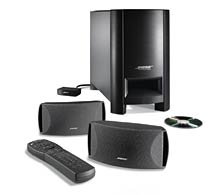If you are in the market for a surround sound system I'm sure you are trying to learn as much as possible about options before you reach the buying stage. One thing to keep in mind is that there are many options and most of them will come down to a matter of taste when all is said and done. There is no right or wrong component or process when it comes to buying a surround sound system only what does and doesn't work for you and the space you have available.
You will find throughout the process that there are many parts, pieces, and components that you may purchase for your surround sound system and even more prices for those individual items. Ultimately the decision comes down to how much of a sound snob you are. Seriously. I must admit that my personal preference is for the most possible sound saturation and the most realistic possible sound as possible. For this reason I am more interested in buying the components as individuals rather than a simple AV receiver. This does not mean that an AV receiver wouldn't be perfectly adequate (especially in relation to the size of my rather small media room) but that I prefer the added control over the sound that individual components provides.
Unfortunately, I cannot tell you which will work best for your situation as your tastes and requirements will also play heavily on which decision is best for you as will your budget. Some people do not place nearly as much emphasis on sound as I do and most people have budget constraints that make individual components seem like a bit of overkill. However, if you spend, as much time as I do submersing yourself in experiences that require sound, then you will find that the investment in these components may be well worth every penny. You will pay a few though and should understand that now.
If you want to build a fabulous surround sound system you will need to start with the preamp or processor. This will be the heart of your sound system and works as a surround processor, AM/FM radio, amplifier, and preamp in one. This piece of equipment receives the signals and then sends them on their merry way. Amazingly enough the information always seems to find its way where it should go-assuming of course that everything is plugged into its proper channel.
The tuner allows you to receive and process AM/FM radio signals, XM or Satellite Radio, and some High Definition signals as well. The amplifier adds power to the sound or as its name implies, amplifies it. This allows the sound to 'reach' across the room so that everyone in the room is touched by it.
These components each achieve functions individually that a good quality AV receiver can accomplish. The difference is always in degrees and depth. The AV receiver allows some of the functionality of each but doesn't quite match the control and nuances that can be achieved with any one of the pieces individually. The average consumer doesn't need that sizeable of an investment in equipment, money, time, or space in order to achieve excellent theater quality sound in their home theater system and that is the important thing to remember.
If you are hoping to imitate a 'theater' experience in an average size room, chances are you will never need anything more than a decent AV receiver and an excellent set of speakers. The more speakers you have in your surround sound system, the better the quality of the sound will be. However, better quality speakers will trump marginal quality equipment any day while marginal quality speakers can still ruin the sound of even the best quality AV equipment. The best advice I can give you when purchasing equipment for your surround sound system is to make sure you put your money in your speakers and sort the rest out afterwards.

